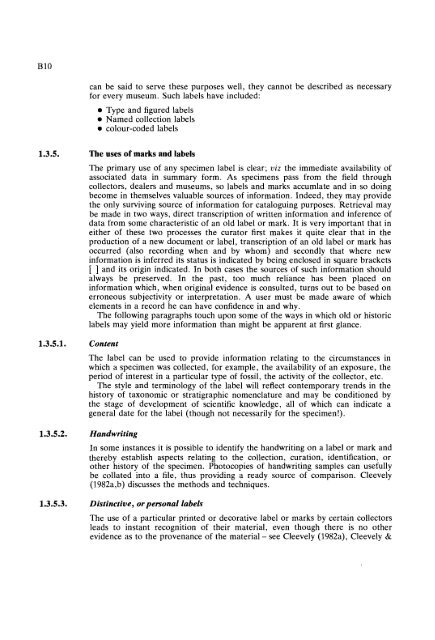GUIDELINES FOR THE CURATION OF GEOLOGICAL MATERIALS
GUIDELINES FOR THE CURATION OF GEOLOGICAL MATERIALS
GUIDELINES FOR THE CURATION OF GEOLOGICAL MATERIALS
Create successful ePaper yourself
Turn your PDF publications into a flip-book with our unique Google optimized e-Paper software.
can be said to serve these purposes well, they cannot be described as necessary<br />
for every museum. Such labels have included:<br />
m Type and figured labels <br />
m Named collection labels <br />
m colour-coded labels <br />
1.3.5. The uses of marks and labels<br />
1.3.5.1. Content<br />
The primary use of any specimen label is clear; viz the immediate availability of<br />
associated data in summary form. As specimens pass from the field through<br />
collectors, dealers and museums, so labels and marks accumlate and in so doing<br />
become in themselves valuable sources of information. Indeed, they may provide<br />
the only surviving source of information for cataloguing purposes. Retrieval may<br />
be made in two ways, direct transcription of written information and inference of<br />
data from some characteristic of an old label or mark. It is very important that in<br />
either of these two processes the curator first makes it quite clear that in the<br />
production of a new document or label, transcription of an old label or mark has<br />
occurred (also recording when and by whom) and secondly that where new<br />
information is inferred its status is indicated by being enclosed in square brackets<br />
[ ] and its origin indicated. In both cases the sources of such information should<br />
always be preserved. In the past, too much reliance has been placed on<br />
information which, when original evidence is consulted, turns out to be based on<br />
erroneous subjectivity or interpretation. A user must be made aware of which<br />
elements in a record he can have confidence in and why.<br />
The following paragraphs touch upon some of the ways in which old or historic<br />
labels may yield more information than might be apparent at first glance.<br />
The label can be used to provide information relating to the circumstances in<br />
which a specimen was collected, for example, the availability of an exposure, the<br />
period of interest in a particular type of fossil, the activity of the collector, etc.<br />
The style and terminology of the label will reflect contemporary trends in the<br />
history of taxonomic or stratigraphic nomenclature and may be conditioned by<br />
the stage of development of scientific knowledge, all of which can indicate a<br />
general date for the label (though not necessarily for the specimen!).<br />
1.3.5.2. Handwriting<br />
In some instances it is possible to identify the handwriting on a label or mark and<br />
thereby establish aspects relating to the collection, curation, identification, or<br />
other history of the specimen. Photocopies of handwriting samples can usefully<br />
be collated into a file, thus providing a ready source of comparison. Cleevely<br />
(1982a,b) discusses the methods and techniques.<br />
1.3.5.3. Distinctive, or personal labels<br />
The use of a particular printed or decorative label or marks by certain collectors<br />
leads to instant recognition of their material, even though there is no other<br />
evidence as to the provenance of the material - see Cleevely (1982a), Cleevely &

















